INSTITUT SUPERIEUR D'ANTHROPOLOGIE
INSTITUTE OF ANTHROPOLOGY
ONLINE COURSES / COURS A DISTANCE
INSCRIPTIONS OUVERTES
REGISTER NOW
SERBIE – 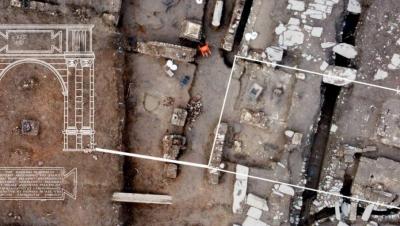 Viminacium - Archaeologists have unearthed an ancient Roman triumphal arch dating back to the third century at Viminacium, a Roman city near the town of Kostolac, 70 km (45 miles) east of Belgrade. Viminacium (Viminacium) or Viminatium, was a major city (provincial capital) and military camp of the Roman province of Moesia (today’s Serbia), and the capital of Moesia Superior. Professor Miomir Korac, one of Serbia’s leading archaeologists, said that the discovery was made during excavations of the main street of Viminacium, the capital of the Roman province of Moesia. “This is the first such triumphal arch in this area..,” Korac told Reuters on Monday. The solution to the riddle – to whom the triumphal gate was dedicated, scientists found when they dug up part of a marble slab with the ruler’s name carved from the almost frozen ground. It was Emperor Caracalla, who grew up in military camps following his father Septimus Severus on campaigns and participated in battles from the age of 15. Archaeologists, based on the material already found, determined that the triumphal arch was built at the end of the second or the latest at the beginning of the third century AD. According to historical sources, an extraordinary event took place in the Upper Mesian capital Viminacium: here Marcus Aurelius Antoninus, better known by the nickname Caracalla, was proclaimed Caesar, ruler, and successor of his father Septimius Severus in 195, from whom he took the title of Augustus three years later. The researchers knew that the triumphal arch was built on the occasion of an event of great importance for the fate of the empire, and the plaque with the remains of the dedication to Caracalla confirmed their conclusions. In his statement to the local press, Dr. Ilija Danković said, “The research plan meant that we first excavate the main Viminacium street – Decumanus. We located it and discovered a 10.4-meter-wide street paved with smooth stone then we came to an elaborate sewer network. The excavation confirmed that there were colonnades of columns on both sides of the street.” All those archaeological remains were expected until the unusual foundations of some imposing building appeared. “We were completely surprised when we discovered that one section of the main street of Viminacium was missing the roadway and its substructure. Instead of them, we came across a foundation foot in the shape of a square, built of massive pieces of limestone. We continued our excavations and discovered three more such feet! It became clear that these were the foundations of a tetrapylon, a building on four pillars, with passages on four sides. There was no doubt that it was one of the trademarks of Roman architecture: the triumphal arch or the triumphal arch,” says Dr. Saša Redžić. The Viminacium triumphal arch was built in the form of a tetrapylon with a single passage and an inscription field above the arched part. Its basic dimensions are 10.40 by 6.25 meters, which is extremely close to the dimensions of the Arco dei Gavi triumphal arch in Verona, whose height is 12.70 meters. A fragment of a marble slab with letters reading CAES/ANTO suggested that the arch was dedicated to Emperor Marcus Aurelius Antoninus, known as Caracalla, who reigned from 198 to 217 AD.
Viminacium - Archaeologists have unearthed an ancient Roman triumphal arch dating back to the third century at Viminacium, a Roman city near the town of Kostolac, 70 km (45 miles) east of Belgrade. Viminacium (Viminacium) or Viminatium, was a major city (provincial capital) and military camp of the Roman province of Moesia (today’s Serbia), and the capital of Moesia Superior. Professor Miomir Korac, one of Serbia’s leading archaeologists, said that the discovery was made during excavations of the main street of Viminacium, the capital of the Roman province of Moesia. “This is the first such triumphal arch in this area..,” Korac told Reuters on Monday. The solution to the riddle – to whom the triumphal gate was dedicated, scientists found when they dug up part of a marble slab with the ruler’s name carved from the almost frozen ground. It was Emperor Caracalla, who grew up in military camps following his father Septimus Severus on campaigns and participated in battles from the age of 15. Archaeologists, based on the material already found, determined that the triumphal arch was built at the end of the second or the latest at the beginning of the third century AD. According to historical sources, an extraordinary event took place in the Upper Mesian capital Viminacium: here Marcus Aurelius Antoninus, better known by the nickname Caracalla, was proclaimed Caesar, ruler, and successor of his father Septimius Severus in 195, from whom he took the title of Augustus three years later. The researchers knew that the triumphal arch was built on the occasion of an event of great importance for the fate of the empire, and the plaque with the remains of the dedication to Caracalla confirmed their conclusions. In his statement to the local press, Dr. Ilija Danković said, “The research plan meant that we first excavate the main Viminacium street – Decumanus. We located it and discovered a 10.4-meter-wide street paved with smooth stone then we came to an elaborate sewer network. The excavation confirmed that there were colonnades of columns on both sides of the street.” All those archaeological remains were expected until the unusual foundations of some imposing building appeared. “We were completely surprised when we discovered that one section of the main street of Viminacium was missing the roadway and its substructure. Instead of them, we came across a foundation foot in the shape of a square, built of massive pieces of limestone. We continued our excavations and discovered three more such feet! It became clear that these were the foundations of a tetrapylon, a building on four pillars, with passages on four sides. There was no doubt that it was one of the trademarks of Roman architecture: the triumphal arch or the triumphal arch,” says Dr. Saša Redžić. The Viminacium triumphal arch was built in the form of a tetrapylon with a single passage and an inscription field above the arched part. Its basic dimensions are 10.40 by 6.25 meters, which is extremely close to the dimensions of the Arco dei Gavi triumphal arch in Verona, whose height is 12.70 meters. A fragment of a marble slab with letters reading CAES/ANTO suggested that the arch was dedicated to Emperor Marcus Aurelius Antoninus, known as Caracalla, who reigned from 198 to 217 AD.
https://arkeonews.net/serbian-archaeologists-unearth-roman-triumphal-arch-dedicated-to-emperor-caracalla/
DANEMARK – 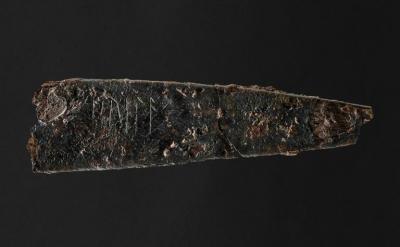 Funen - - Archaeologists have found a small knife with a completely unique runic inscription that can be dated almost 2000 years ago. Archaeologists from Museum Odense have found Denmark’s oldest runic inscription, hirila, inscribed on a nearly 2000-year-old knife blade. The knife was found under the remains of an urn grave in a small burial ground east of Odense on the island of Funen and can be dated as far back as 150 AD. On the 8cm iron knife, the five characters, each about 0.5cm tall, followed by three grooves, spell out hirila, which means “little sword” in Old Norse. They, along with an inscribed bone comb discovered nearby in 1865, are Denmark’s oldest runes. Jakob Bonde, the city’s museum curator and archeologist who made the discovery, said he initially thought it was an ordinary knife because the runes were not visible, but after conservators cleaned it, it was clear that it contained a word. The runes on the knife are written with the oldest known runic alphabet, and therefore the new find is a very important part of the understanding and interpretation of the very oldest use of writing in Denmark and the Nordic region. Whether hirila is the name of the knife itself, or whether it is the name of the knife’s owner, Museum Odense archaeologists cannot determine with certainty. But there is no doubt that it was a treasured possession.
Funen - - Archaeologists have found a small knife with a completely unique runic inscription that can be dated almost 2000 years ago. Archaeologists from Museum Odense have found Denmark’s oldest runic inscription, hirila, inscribed on a nearly 2000-year-old knife blade. The knife was found under the remains of an urn grave in a small burial ground east of Odense on the island of Funen and can be dated as far back as 150 AD. On the 8cm iron knife, the five characters, each about 0.5cm tall, followed by three grooves, spell out hirila, which means “little sword” in Old Norse. They, along with an inscribed bone comb discovered nearby in 1865, are Denmark’s oldest runes. Jakob Bonde, the city’s museum curator and archeologist who made the discovery, said he initially thought it was an ordinary knife because the runes were not visible, but after conservators cleaned it, it was clear that it contained a word. The runes on the knife are written with the oldest known runic alphabet, and therefore the new find is a very important part of the understanding and interpretation of the very oldest use of writing in Denmark and the Nordic region. Whether hirila is the name of the knife itself, or whether it is the name of the knife’s owner, Museum Odense archaeologists cannot determine with certainty. But there is no doubt that it was a treasured possession.
https://arkeonews.net/an-engraving-on-an-almost-2000-year-old-knife-believed-to-be-the-oldest-runes-ever-found-in-denmark-has-been-discovered-by-archaeologists/
IRLANDE – 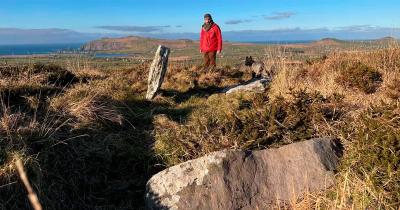
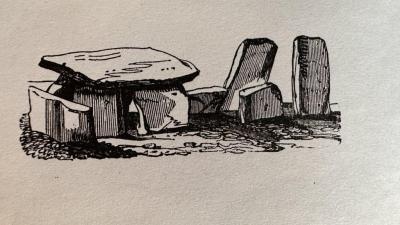 Kerry - A “lost” 4,000-year-old wedge tomb has been rediscovered in County Kerry, in the peninsular southwest region of Ireland. The megalithic tomb, known locally as Altóir na Gréine (the sun altar), was believed to have been destroyed in the 1840s, with its stones broken and carried away for use as building material. Lady Georgiana Chatterton, an English aristocrat and traveler, sketched the monument when she visited the site in 1838. She described the site as a “curious piece of antiquity,” suggesting it was used for Sun sacrifices. owever, when the antiquarian Richard Hitchcock came to West Kerry to inspect the tomb in 1852 he found the monument no longer existed, “the stones which composed it having been broken and carried away for building purposes as if there were no others in the neighborhood”. Although a 19th-century record of a burial tomb was found close to Baile an Fheirtéaraigh, the precise location of the monument has been lost. But now the tomb has been rediscovered, dating back about 4,000 years. However, the 180-year-old mystery has now been solved by folklorist Billy Mag Fhloinn. The folklorist has not only found the prehistoric site, but he has also discovered some of the large stones, which had been believed to have been removed, still in situ. Archaeologist Caimin O’Brien, the National Monuments Service in Dublin, confirmed that the stones represented about a quarter of the original Bronze Age wedge tomb, dating between 2500 BC and 2000 BC. Wedge-tombs are the most numerous megalithic burial structures found on the Dingle Peninsula.
Kerry - A “lost” 4,000-year-old wedge tomb has been rediscovered in County Kerry, in the peninsular southwest region of Ireland. The megalithic tomb, known locally as Altóir na Gréine (the sun altar), was believed to have been destroyed in the 1840s, with its stones broken and carried away for use as building material. Lady Georgiana Chatterton, an English aristocrat and traveler, sketched the monument when she visited the site in 1838. She described the site as a “curious piece of antiquity,” suggesting it was used for Sun sacrifices. owever, when the antiquarian Richard Hitchcock came to West Kerry to inspect the tomb in 1852 he found the monument no longer existed, “the stones which composed it having been broken and carried away for building purposes as if there were no others in the neighborhood”. Although a 19th-century record of a burial tomb was found close to Baile an Fheirtéaraigh, the precise location of the monument has been lost. But now the tomb has been rediscovered, dating back about 4,000 years. However, the 180-year-old mystery has now been solved by folklorist Billy Mag Fhloinn. The folklorist has not only found the prehistoric site, but he has also discovered some of the large stones, which had been believed to have been removed, still in situ. Archaeologist Caimin O’Brien, the National Monuments Service in Dublin, confirmed that the stones represented about a quarter of the original Bronze Age wedge tomb, dating between 2500 BC and 2000 BC. Wedge-tombs are the most numerous megalithic burial structures found on the Dingle Peninsula.
https://arkeonews.net/lost-4000-year-old-wedge-tomb-rediscovered-in-ireland/
ANGLETERRE – 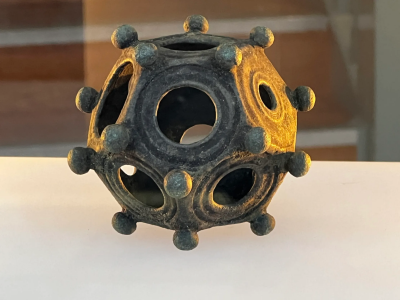 Norton Disney - Amateur archaeologists have unearthed a striking Roman dodecahedron in the serene countryside of Norton Disney, England, a mysterious class of objects that have baffled experts for centuries. The object’s purpose is unknown to modern archaeologists because the 12-sided metal shell lacks markings and no mention of them can be found in contemporary literature. About thirty-two examples, complete or in part, from Roman Britain are known to exist. The Norton Disney example now makes 33. Throughout the Roman world, there are about 130 known examples. which are located in the Roman provinces of the northwest. The Norton Disney dodecahedron is an exceptionally good example and the only one in the Midlands. It’s beautifully crafted, undamaged, and in perfect shape. It exhibits exquisite craftsmanship and a superior level of finishing. It is a prime example of expertly crafted and superbly finished work. The Norton Disney dodecahedron is a copper alloy object. 75% copper, 7% tin and 18 % lead. It’s overall height is 8cm. Its overall width is 8.6cm and weighs 254g. It is also an important find in that it was found “in situ”, where it was deliberately placed some 1700 years before with 4th-century Roman pottery in some sort of excavated hole or quarry pit. The purpose of dodecahedra is still very unclear because there are no known descriptions of them in Roman literature. They won’t be measuring devices because they aren’t a standard size. They are not a tool because they don’t exhibit any wear. They’re also not knitting machines. Dodecahedron took a great deal of time, effort, and skill to construct, so it wasn’t used for everyday tasks, especially since there are other materials that could have served the same function. It is believed that ritual and religious uses are the most likely uses.
Norton Disney - Amateur archaeologists have unearthed a striking Roman dodecahedron in the serene countryside of Norton Disney, England, a mysterious class of objects that have baffled experts for centuries. The object’s purpose is unknown to modern archaeologists because the 12-sided metal shell lacks markings and no mention of them can be found in contemporary literature. About thirty-two examples, complete or in part, from Roman Britain are known to exist. The Norton Disney example now makes 33. Throughout the Roman world, there are about 130 known examples. which are located in the Roman provinces of the northwest. The Norton Disney dodecahedron is an exceptionally good example and the only one in the Midlands. It’s beautifully crafted, undamaged, and in perfect shape. It exhibits exquisite craftsmanship and a superior level of finishing. It is a prime example of expertly crafted and superbly finished work. The Norton Disney dodecahedron is a copper alloy object. 75% copper, 7% tin and 18 % lead. It’s overall height is 8cm. Its overall width is 8.6cm and weighs 254g. It is also an important find in that it was found “in situ”, where it was deliberately placed some 1700 years before with 4th-century Roman pottery in some sort of excavated hole or quarry pit. The purpose of dodecahedra is still very unclear because there are no known descriptions of them in Roman literature. They won’t be measuring devices because they aren’t a standard size. They are not a tool because they don’t exhibit any wear. They’re also not knitting machines. Dodecahedron took a great deal of time, effort, and skill to construct, so it wasn’t used for everyday tasks, especially since there are other materials that could have served the same function. It is believed that ritual and religious uses are the most likely uses.
https://arkeonews.net/enigmas-roman-dodecahedron-uncovered-by-amateur-archaeologists-in-the-uk/
CHINE – 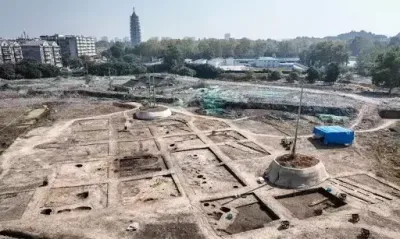 Changgan - The site of Changgan ancient city, unearthed in Xijie site of east China's Nanjing City, has been confirmed to date back to 3,100 years ago, extending Nanjing's history by more than 600 years, Nanjing institute of archaeology said. This was reported by The Xinhua News Agency. The site of the ancient city, named "Changgan," the earliest known name of the city of Nanjing, features relics of a platform, ring ditches, walls, doorways and sacrificial pits. "During excavations that began in 2017, archaeologists unearthed four ring ditches from the Shang and Zhou dynasties (1600 BC-256 BC), containing collapsed rammed-earth walls", – said Chen Dahai, an archaeologist with the institute, responsible for the excavation. "We also found more evidence supporting our conclusion, including a well on the side of the ditch that was originally constructed during the late Shang Dynasty and the unearthed pottery featuring triangular and ladder-pattern decorations with clear characteristics of the Shang Dynasty", – Chen added. "Various artifacts, including pig bones and charcoal, date back to the period ranging from the late Shang Dynasty to the early Zhou Dynasty, according to carbon-14 dating data", – Chen said. Up to now, the excavation area at the Xijie site has reached 12,000 square meters, with more than 500 relics of various types and over 10,000 specimens of archaeological importance unearthed.
Changgan - The site of Changgan ancient city, unearthed in Xijie site of east China's Nanjing City, has been confirmed to date back to 3,100 years ago, extending Nanjing's history by more than 600 years, Nanjing institute of archaeology said. This was reported by The Xinhua News Agency. The site of the ancient city, named "Changgan," the earliest known name of the city of Nanjing, features relics of a platform, ring ditches, walls, doorways and sacrificial pits. "During excavations that began in 2017, archaeologists unearthed four ring ditches from the Shang and Zhou dynasties (1600 BC-256 BC), containing collapsed rammed-earth walls", – said Chen Dahai, an archaeologist with the institute, responsible for the excavation. "We also found more evidence supporting our conclusion, including a well on the side of the ditch that was originally constructed during the late Shang Dynasty and the unearthed pottery featuring triangular and ladder-pattern decorations with clear characteristics of the Shang Dynasty", – Chen added. "Various artifacts, including pig bones and charcoal, date back to the period ranging from the late Shang Dynasty to the early Zhou Dynasty, according to carbon-14 dating data", – Chen said. Up to now, the excavation area at the Xijie site has reached 12,000 square meters, with more than 500 relics of various types and over 10,000 specimens of archaeological importance unearthed.
https://ukranews.com/en/news/977474-discovery-of-ancient-city-site-extends-nanjing-s-history-to-3-100-years-ago
FRANCE – 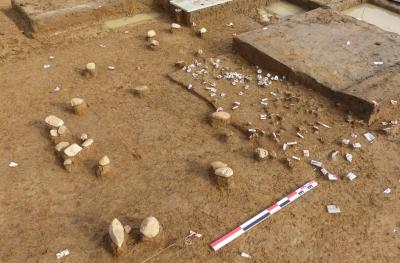 - Fragnes-La Loyère - Entre le cours de la Saône à l’est et la Côte chalonnaise à l’ouest, le site est implanté au sommet d’un versant dominant un affluent de la Saône, la Thalie. Les premiers résultats permettent de le dater entre 24 000 et 22 000 ans avant notre ère, au cours du dernier maximum glaciaire. Les conditions climatiques qui règnent alors sur la région sont particulièrement rigoureuses. La plaine de Saône est une vaste steppe froide au couvert végétal peu développé, essentiellement composé d’herbacées, où évoluent des espèces adaptées à ces milieux extrêmes et dominées par les troupeaux d’herbivores comme le renne, le cheval, le bison ou le mammouth. Les chasseurs solutréens vont parcourir ces territoires notamment lors d’expéditions de chasse. Le niveau archéologique apparaît entre 40 et 50 cm sous la surface du sol actuel. L’état de conservation exceptionnel du mobilier lithique, représenté dans toutes ses dimensions, des esquilles de quelques millimètres aux objets de plus de 20 cm, atteste l’excellent état de conservation du gisement. En revanche, l’acidité naturelle du sol a empêché la conservation de restes osseux. Le site est formé d’une concentration de silex taillés qui s’inscrit dans un ovale de 5 m de long par 4 m de large. À l’intérieur de cet espace délimité par de gros galets de quartzite, des zones de taille de silex sont attestées par des amas de débitage, parfois très denses (300 objets / m²). Une étude approfondie de la distribution des objets permettra de définir plus précisément l’organisation de ce campement. L’industrie lithique, composée de plus de 4 000 objets, est produite à partir de silex issus des formations du Crétacé supérieur locales et régionales du Châlonnais et du Mâconnais. Toutes les étapes de la production des lames utilisées comme support pour la confection d’outils sont présentes sur place. Cet ensemble comprend des nucléus (blocs de silex à partir desquels les lames vont être débitées), des déchets techniques ainsi que des lames utilisables brutes ou transformées en outils. Les Solutréens ont utilisé des percuteurs en pierre tendre, en grès. L’outillage, peu diversifié, témoigne d’une forme de spécialisation des activités pratiquées sur le site. Il est principalement représenté par des lames appointées, désignées sous le terme de « pointe à face plane », outil emblématique de la phase ancienne du Solutréen. Des burins complètent l’assemblage, la plupart étant également aménagés à partir de pointes à face plane. Des études tracéologiques permettront de déterminer la fonction de ces objets (outils de découpe, armature de projectile…). Le Solutréen ancien est peu documenté avec moins d’une dizaine de références en France. Le site de Fragnes-La Loyère constitue donc un jalon important pour la connaissance de cette culture.
- Fragnes-La Loyère - Entre le cours de la Saône à l’est et la Côte chalonnaise à l’ouest, le site est implanté au sommet d’un versant dominant un affluent de la Saône, la Thalie. Les premiers résultats permettent de le dater entre 24 000 et 22 000 ans avant notre ère, au cours du dernier maximum glaciaire. Les conditions climatiques qui règnent alors sur la région sont particulièrement rigoureuses. La plaine de Saône est une vaste steppe froide au couvert végétal peu développé, essentiellement composé d’herbacées, où évoluent des espèces adaptées à ces milieux extrêmes et dominées par les troupeaux d’herbivores comme le renne, le cheval, le bison ou le mammouth. Les chasseurs solutréens vont parcourir ces territoires notamment lors d’expéditions de chasse. Le niveau archéologique apparaît entre 40 et 50 cm sous la surface du sol actuel. L’état de conservation exceptionnel du mobilier lithique, représenté dans toutes ses dimensions, des esquilles de quelques millimètres aux objets de plus de 20 cm, atteste l’excellent état de conservation du gisement. En revanche, l’acidité naturelle du sol a empêché la conservation de restes osseux. Le site est formé d’une concentration de silex taillés qui s’inscrit dans un ovale de 5 m de long par 4 m de large. À l’intérieur de cet espace délimité par de gros galets de quartzite, des zones de taille de silex sont attestées par des amas de débitage, parfois très denses (300 objets / m²). Une étude approfondie de la distribution des objets permettra de définir plus précisément l’organisation de ce campement. L’industrie lithique, composée de plus de 4 000 objets, est produite à partir de silex issus des formations du Crétacé supérieur locales et régionales du Châlonnais et du Mâconnais. Toutes les étapes de la production des lames utilisées comme support pour la confection d’outils sont présentes sur place. Cet ensemble comprend des nucléus (blocs de silex à partir desquels les lames vont être débitées), des déchets techniques ainsi que des lames utilisables brutes ou transformées en outils. Les Solutréens ont utilisé des percuteurs en pierre tendre, en grès. L’outillage, peu diversifié, témoigne d’une forme de spécialisation des activités pratiquées sur le site. Il est principalement représenté par des lames appointées, désignées sous le terme de « pointe à face plane », outil emblématique de la phase ancienne du Solutréen. Des burins complètent l’assemblage, la plupart étant également aménagés à partir de pointes à face plane. Des études tracéologiques permettront de déterminer la fonction de ces objets (outils de découpe, armature de projectile…). Le Solutréen ancien est peu documenté avec moins d’une dizaine de références en France. Le site de Fragnes-La Loyère constitue donc un jalon important pour la connaissance de cette culture.
https://www.inrap.fr/decouverte-d-un-nouveau-site-solutreen-ancien-en-bourgogne-saone-et-loire-17741#
MOLDAVIE / UKRAINE – -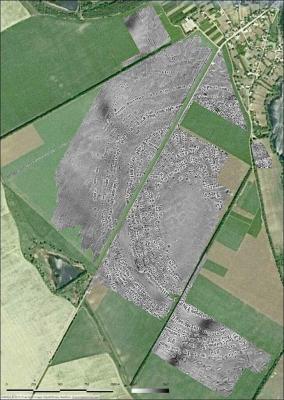
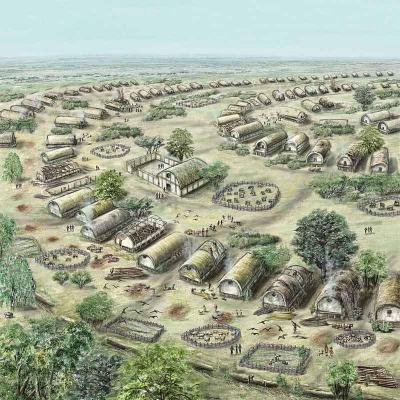 Les chercheurs ont essayé de reconstituer le régime alimentaire des populations humaines dans des méga-colonies des sociétés Trypillia apparues au Néolithique sur les territoires actuels de la Moldavie et de l’Ukraine. Il y a 6 000 ans, ces sociétés ont construit de grandes colonies planifiées couvrant des superficies allant jusqu’à près de 320 hectares, qui, selon de les chercheurs, pouvaient abriter jusqu’à 15 000 individus. Les chercheurs ont essayé de comprendre les méthodes mises en œuvre pour nourrir un si grand nombre d’individus au néolithique ? Ces méga-colonies sont, à ce jour, les plus grands regroupements humains connues du Néolithique. Et si c’est bien l’élevage et l’agriculture qui étaient utilisés, les chercheurs ne savaient pas comment la part de ces deux activités étaient réparties…On pensait auparavant que ces grandes communautés dépendaient d’une agriculture de subsistance, mais selon le paléoécologue de Kiel, le docteur Frank Schlütz : « L’approvisionnement des habitants des méga-colonies reposait sur une gestion extrêmement sophistiquée de la nourriture et des pâturages. » Les chercheurs ont analysé la composition isotopique du carbone et de l’azote présents dans les restes humains, les os d’animaux et les cultures carbonisées trouvés sur les sites néolithiques de la culture Trypillia. C’est une véritable compilation des centaines d’échantillons collectés sur les sites depuis plus de 10 ans. Les résultats des analyses révèlent que les habitants de ces anciennes colonies étaient essentiellement végétariens. Ils se nourrissaient principalement et jusqu’à 46 % de légumineuses, était équilibré en calories et en acides aminés indispensables avec notamment des pois. La viande, quant à elle, ne représentait qu’une faible proportion – seulement 10 % – de l’apport calorique Les études ont notamment permis de comprendre comment les néolithiques organisaient le cycle de production. Les bovins et ovins devaient être élevés dans des prairies clôturées à proximité immédiate de la colonie. Ces animaux de pâturage produisaient des quantités importantes de fumier. Les matières fécales permettaient de fertiliser les cultures. De plus, la paille de pois obtenue servait probablement de nourriture au bétail qui paissait dans les pâturages…
Les chercheurs ont essayé de reconstituer le régime alimentaire des populations humaines dans des méga-colonies des sociétés Trypillia apparues au Néolithique sur les territoires actuels de la Moldavie et de l’Ukraine. Il y a 6 000 ans, ces sociétés ont construit de grandes colonies planifiées couvrant des superficies allant jusqu’à près de 320 hectares, qui, selon de les chercheurs, pouvaient abriter jusqu’à 15 000 individus. Les chercheurs ont essayé de comprendre les méthodes mises en œuvre pour nourrir un si grand nombre d’individus au néolithique ? Ces méga-colonies sont, à ce jour, les plus grands regroupements humains connues du Néolithique. Et si c’est bien l’élevage et l’agriculture qui étaient utilisés, les chercheurs ne savaient pas comment la part de ces deux activités étaient réparties…On pensait auparavant que ces grandes communautés dépendaient d’une agriculture de subsistance, mais selon le paléoécologue de Kiel, le docteur Frank Schlütz : « L’approvisionnement des habitants des méga-colonies reposait sur une gestion extrêmement sophistiquée de la nourriture et des pâturages. » Les chercheurs ont analysé la composition isotopique du carbone et de l’azote présents dans les restes humains, les os d’animaux et les cultures carbonisées trouvés sur les sites néolithiques de la culture Trypillia. C’est une véritable compilation des centaines d’échantillons collectés sur les sites depuis plus de 10 ans. Les résultats des analyses révèlent que les habitants de ces anciennes colonies étaient essentiellement végétariens. Ils se nourrissaient principalement et jusqu’à 46 % de légumineuses, était équilibré en calories et en acides aminés indispensables avec notamment des pois. La viande, quant à elle, ne représentait qu’une faible proportion – seulement 10 % – de l’apport calorique Les études ont notamment permis de comprendre comment les néolithiques organisaient le cycle de production. Les bovins et ovins devaient être élevés dans des prairies clôturées à proximité immédiate de la colonie. Ces animaux de pâturage produisaient des quantités importantes de fumier. Les matières fécales permettaient de fertiliser les cultures. De plus, la paille de pois obtenue servait probablement de nourriture au bétail qui paissait dans les pâturages…
« Nous sommes arrivés à la conclusion qu’une grande partie du bétail et des moutons étaient élevés dans des pâturages clôturés. Et les excréments d’animaux produits là-bas étaient utilisés par l’homme pour fertiliser intensivement les pois», explique Frank Schlütz. Selon les conclusions de l’étude, « L’épanouissement des premières méga-populations d’Europe dépendait d’une méga-économie avancée et intégrale incluant une gestion sophistiquée des excréments. » La disparition des méga colonies n’est toujours pas expliquée mais les chercheurs penchent pour une hausse des inégalités sociales qui aurait incité les individus à chercher des structures plus petites.
https://www.hominides.com/mega-colonies-neolithiques-europe-l-est-majoritairement-vegetariennes/